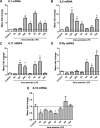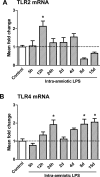Intraamniotic lipopolysaccharide exposure changes cell populations and structure of the ovine fetal thymus
- PMID: 23314960
- PMCID: PMC3702021
- DOI: 10.1177/1933719112472742
Intraamniotic lipopolysaccharide exposure changes cell populations and structure of the ovine fetal thymus
Abstract
Rationale: Chorioamnionitis induces preterm delivery and acute involution of the fetal thymus which is associated with postnatal inflammatory disorders. We studied the immune response, cell composition, and architecture of the fetal thymus following intraamniotic lipopolysaccharide (LPS) exposure.
Methods: Time-mated ewes received an intraamniotic injection of LPS 5, 12, or 24 hours or 2, 4, 8, or 15 days before delivery at 125 days gestational age (term = 150 days).
Results: The LPS exposure resulted in decreased blood lymphocytes within 5 hours and decreased thymic corticomedullary ratio within 24 hours. Thymic interleukin 6 (IL6) and IL17 messenger RNA (mRNA) increased 5-fold 24 hours post-LPS exposure. Increased toll-like receptor 4 (TLR4) mRNA and nuclear factor κB positive cells at 24 hours after LPS delivery demonstrated acute thymic activation. Both TLR4 and IL1 mRNA increased by 5-fold and the number of Foxp3-positive cells (Foxp3+ cells) decreased 15 days after exposure.
Conclusion: Intraamniotic LPS exposure caused a proinflammatory response, involution, and a persistent depletion of thymic Foxp3+ cells indicating disturbance of the fetal immune homeostasis.
Keywords: fetal inflammatory response syndrome; immune modulation; prematurity; thymic involution.
Conflict of interest statement
Figures







Similar articles
-
Ovine fetal thymus response to lipopolysaccharide-induced chorioamnionitis and antenatal corticosteroids.PLoS One. 2012;7(5):e38257. doi: 10.1371/journal.pone.0038257. Epub 2012 May 31. PLoS One. 2012. PMID: 22693607 Free PMC article.
-
Thymic changes after chorioamnionitis induced by intraamniotic lipopolysaccharide in fetal sheep.Am J Obstet Gynecol. 2010 May;202(5):476.e1-9. doi: 10.1016/j.ajog.2010.02.035. Am J Obstet Gynecol. 2010. PMID: 20452494 Free PMC article.
-
Pharmacological blockade of the interleukin-1 receptor suppressed Escherichia coli lipopolysaccharide-induced neuroinflammation in preterm fetal sheep.Am J Obstet Gynecol MFM. 2023 Nov;5(11):101124. doi: 10.1016/j.ajogmf.2023.101124. Epub 2023 Aug 18. Am J Obstet Gynecol MFM. 2023. PMID: 37597799
-
Intra-amniotic LPS modulation of TLR signaling in lung and blood monocytes of fetal sheep.Innate Immun. 2009 Apr;15(2):101-7. doi: 10.1177/1753425908100455. Innate Immun. 2009. PMID: 19318420
-
Fetal immune response to chorioamnionitis.Semin Reprod Med. 2014 Jan;32(1):56-67. doi: 10.1055/s-0033-1361823. Epub 2014 Jan 3. Semin Reprod Med. 2014. PMID: 24390922 Free PMC article. Review.
Cited by
-
Intra-amniotic IL-1β induces fetal inflammation in rhesus monkeys and alters the regulatory T cell/IL-17 balance.J Immunol. 2013 Aug 1;191(3):1102-9. doi: 10.4049/jimmunol.1300270. Epub 2013 Jun 21. J Immunol. 2013. PMID: 23794628 Free PMC article.
-
Intestinal Goblet Cell Loss during Chorioamnionitis in Fetal Lambs: Mechanistic Insights and Postnatal Implications.Int J Mol Sci. 2021 Feb 16;22(4):1946. doi: 10.3390/ijms22041946. Int J Mol Sci. 2021. PMID: 33669331 Free PMC article.
-
Damage-Associated Molecular Pattern and Fetal Membrane Vascular Injury and Collagen Disorganization in Lipopolysaccharide-Induced Intra-amniotic Inflammation in Fetal Sheep.Reprod Sci. 2016 Jan;23(1):69-80. doi: 10.1177/1933719115594014. Epub 2015 Jul 7. Reprod Sci. 2016. PMID: 26156854 Free PMC article.
-
Alterations of Thymic Epithelial Cells in Lipopolysaccharide-induced Neonatal Thymus Involution.Chin Med J (Engl). 2016 Jan 5;129(1):59-65. doi: 10.4103/0366-6999.172577. Chin Med J (Engl). 2016. PMID: 26712434 Free PMC article.
-
Altered bone marrow lymphopoiesis and interleukin-6-dependent inhibition of thymocyte differentiation contribute to thymic atrophy during Trypanosoma cruzi infection.Oncotarget. 2017 Mar 14;8(11):17551-17561. doi: 10.18632/oncotarget.14886. Oncotarget. 2017. PMID: 28147332 Free PMC article.
References
-
- Goldenberg RL, Hauth JC, Andrews WW. Intrauterine infection and preterm delivery. N Engl J Med. 2000;342(20):1500–1507. - PubMed
-
- Redline RW. Placental inflammation. Semin Neonatol. 2004;9(4):265–274. - PubMed
-
- Hagberg H, Wennerholm UB, Savman K. Sequelae of chorioamnionitis. Curr Opin Infect Dis. 2002;15(3):301–306. - PubMed
-
- Goldenberg RL, Hauth JC, Andrews WW. Intrauterine infection and preterm delivery. N Engl J Med. 2000;342(20):1500–1507. - PubMed
Publication types
MeSH terms
Substances
Grants and funding
LinkOut - more resources
Full Text Sources
Other Literature Sources

